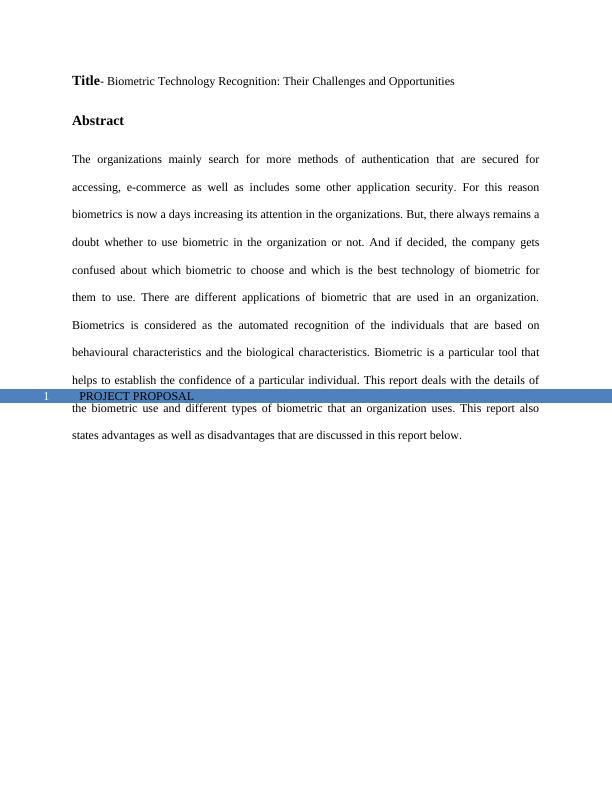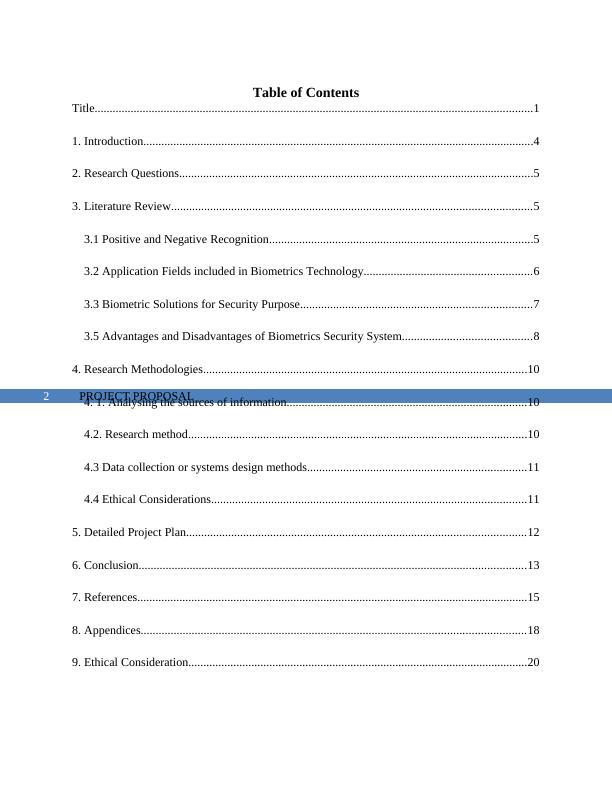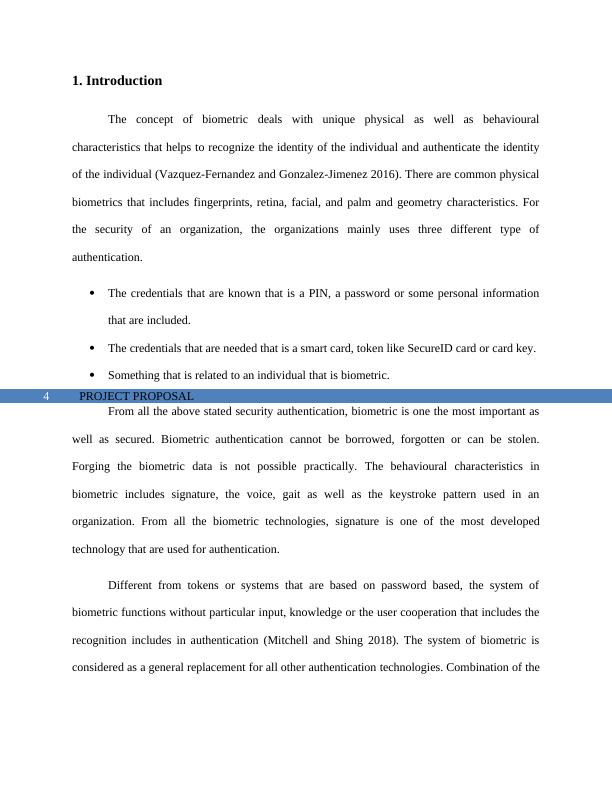Biometric Technology Recognition: Challenges and Opportunities
Added on 2022-12-12
21 Pages4467 Words336 Views
Running head: PROJECT PROPOSAL
Project Proposal
Name of Student-
Name of University-
Author’s Note-
Project Proposal
Name of Student-
Name of University-
Author’s Note-

PROJECT PROPOSAL1
Title- Biometric Technology Recognition: Their Challenges and Opportunities
Abstract
The organizations mainly search for more methods of authentication that are secured for
accessing, e-commerce as well as includes some other application security. For this reason
biometrics is now a days increasing its attention in the organizations. But, there always remains a
doubt whether to use biometric in the organization or not. And if decided, the company gets
confused about which biometric to choose and which is the best technology of biometric for
them to use. There are different applications of biometric that are used in an organization.
Biometrics is considered as the automated recognition of the individuals that are based on
behavioural characteristics and the biological characteristics. Biometric is a particular tool that
helps to establish the confidence of a particular individual. This report deals with the details of
the biometric use and different types of biometric that an organization uses. This report also
states advantages as well as disadvantages that are discussed in this report below.
Title- Biometric Technology Recognition: Their Challenges and Opportunities
Abstract
The organizations mainly search for more methods of authentication that are secured for
accessing, e-commerce as well as includes some other application security. For this reason
biometrics is now a days increasing its attention in the organizations. But, there always remains a
doubt whether to use biometric in the organization or not. And if decided, the company gets
confused about which biometric to choose and which is the best technology of biometric for
them to use. There are different applications of biometric that are used in an organization.
Biometrics is considered as the automated recognition of the individuals that are based on
behavioural characteristics and the biological characteristics. Biometric is a particular tool that
helps to establish the confidence of a particular individual. This report deals with the details of
the biometric use and different types of biometric that an organization uses. This report also
states advantages as well as disadvantages that are discussed in this report below.

PROJECT PROPOSAL2
Table of Contents
Title..................................................................................................................................................1
1. Introduction..................................................................................................................................4
2. Research Questions......................................................................................................................5
3. Literature Review........................................................................................................................5
3.1 Positive and Negative Recognition........................................................................................5
3.2 Application Fields included in Biometrics Technology........................................................6
3.3 Biometric Solutions for Security Purpose.............................................................................7
3.5 Advantages and Disadvantages of Biometrics Security System...........................................8
4. Research Methodologies............................................................................................................10
4. 1. Analysing the sources of information................................................................................10
4.2. Research method.................................................................................................................10
4.3 Data collection or systems design methods.........................................................................11
4.4 Ethical Considerations.........................................................................................................11
5. Detailed Project Plan.................................................................................................................12
6. Conclusion.................................................................................................................................13
7. References..................................................................................................................................15
8. Appendices................................................................................................................................18
9. Ethical Consideration.................................................................................................................20
Table of Contents
Title..................................................................................................................................................1
1. Introduction..................................................................................................................................4
2. Research Questions......................................................................................................................5
3. Literature Review........................................................................................................................5
3.1 Positive and Negative Recognition........................................................................................5
3.2 Application Fields included in Biometrics Technology........................................................6
3.3 Biometric Solutions for Security Purpose.............................................................................7
3.5 Advantages and Disadvantages of Biometrics Security System...........................................8
4. Research Methodologies............................................................................................................10
4. 1. Analysing the sources of information................................................................................10
4.2. Research method.................................................................................................................10
4.3 Data collection or systems design methods.........................................................................11
4.4 Ethical Considerations.........................................................................................................11
5. Detailed Project Plan.................................................................................................................12
6. Conclusion.................................................................................................................................13
7. References..................................................................................................................................15
8. Appendices................................................................................................................................18
9. Ethical Consideration.................................................................................................................20

PROJECT PROPOSAL3

PROJECT PROPOSAL4
1. Introduction
The concept of biometric deals with unique physical as well as behavioural
characteristics that helps to recognize the identity of the individual and authenticate the identity
of the individual (Vazquez-Fernandez and Gonzalez-Jimenez 2016). There are common physical
biometrics that includes fingerprints, retina, facial, and palm and geometry characteristics. For
the security of an organization, the organizations mainly uses three different type of
authentication.
The credentials that are known that is a PIN, a password or some personal information
that are included.
The credentials that are needed that is a smart card, token like SecureID card or card key.
Something that is related to an individual that is biometric.
From all the above stated security authentication, biometric is one the most important as
well as secured. Biometric authentication cannot be borrowed, forgotten or can be stolen.
Forging the biometric data is not possible practically. The behavioural characteristics in
biometric includes signature, the voice, gait as well as the keystroke pattern used in an
organization. From all the biometric technologies, signature is one of the most developed
technology that are used for authentication.
Different from tokens or systems that are based on password based, the system of
biometric functions without particular input, knowledge or the user cooperation that includes the
recognition includes in authentication (Mitchell and Shing 2018). The system of biometric is
considered as a general replacement for all other authentication technologies. Combination of the
1. Introduction
The concept of biometric deals with unique physical as well as behavioural
characteristics that helps to recognize the identity of the individual and authenticate the identity
of the individual (Vazquez-Fernandez and Gonzalez-Jimenez 2016). There are common physical
biometrics that includes fingerprints, retina, facial, and palm and geometry characteristics. For
the security of an organization, the organizations mainly uses three different type of
authentication.
The credentials that are known that is a PIN, a password or some personal information
that are included.
The credentials that are needed that is a smart card, token like SecureID card or card key.
Something that is related to an individual that is biometric.
From all the above stated security authentication, biometric is one the most important as
well as secured. Biometric authentication cannot be borrowed, forgotten or can be stolen.
Forging the biometric data is not possible practically. The behavioural characteristics in
biometric includes signature, the voice, gait as well as the keystroke pattern used in an
organization. From all the biometric technologies, signature is one of the most developed
technology that are used for authentication.
Different from tokens or systems that are based on password based, the system of
biometric functions without particular input, knowledge or the user cooperation that includes the
recognition includes in authentication (Mitchell and Shing 2018). The system of biometric is
considered as a general replacement for all other authentication technologies. Combination of the

PROJECT PROPOSAL5
approaches of a biometric with some other methods does not includes much security which does
not include user cooperation that are included.
2. Research Questions
The research questions that this research paper addresses are listed below:
1. What are the biometric solutions that are used for security purposes of authentication?
2. What are the fields that uses biometric technology for its security purposes?
3. What are the opportunities and drawbacks of using biometric technology?
3. Literature Review
3.1 Positive and Negative Recognition
As stated by Chandy et al. (2017), there are possible two kinds of applications in
biometrics that can be established. One is negative recognition and the other is positive
recognition. Both of these recognitions are explained below:
Positive recognition: The applications that does not require the users to give its identity
for the convenience comes under this group. The process of identification requires less
operations compared to the verification of the user and the identification process is easy to
operate. The verification of identity is mainly used in the place of positive recognition (Alsaadi
2015). The operation mode of positive recognition is very interesting and the user might be
interested to be recognized. This process of recognition is positive. If recognition is not done, the
attempt of the individual will be rejected.
Negative recognition: Negative recognition mainly includes a system to establish if a
person denies of being that person (Mahadi et al. 2018). The main purpose of including the
approaches of a biometric with some other methods does not includes much security which does
not include user cooperation that are included.
2. Research Questions
The research questions that this research paper addresses are listed below:
1. What are the biometric solutions that are used for security purposes of authentication?
2. What are the fields that uses biometric technology for its security purposes?
3. What are the opportunities and drawbacks of using biometric technology?
3. Literature Review
3.1 Positive and Negative Recognition
As stated by Chandy et al. (2017), there are possible two kinds of applications in
biometrics that can be established. One is negative recognition and the other is positive
recognition. Both of these recognitions are explained below:
Positive recognition: The applications that does not require the users to give its identity
for the convenience comes under this group. The process of identification requires less
operations compared to the verification of the user and the identification process is easy to
operate. The verification of identity is mainly used in the place of positive recognition (Alsaadi
2015). The operation mode of positive recognition is very interesting and the user might be
interested to be recognized. This process of recognition is positive. If recognition is not done, the
attempt of the individual will be rejected.
Negative recognition: Negative recognition mainly includes a system to establish if a
person denies of being that person (Mahadi et al. 2018). The main purpose of including the

End of preview
Want to access all the pages? Upload your documents or become a member.
Related Documents
Biometric Authentication: System Security & Privacylg...
|6
|3012
|32
BIOMETRIC VERIFICATION.lg...
|3
|388
|88
Biometric for Authenticationlg...
|7
|3210
|268
Research Project - Assignment PDFlg...
|7
|1519
|75
Smart Home Automation by Biometrics Assignment 2022lg...
|33
|6155
|49
Biometrics for Authentication PDFlg...
|4
|3762
|95